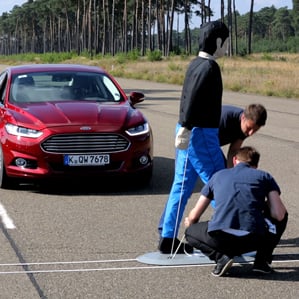Ford to Add Pedestrian Detection to Its Cars
Ford is giving its cars the ability to spot—and avoid hitting—pedestrians using a combination of radar and camera sensing. The system will appear in Europe next year on Ford’s Mondeo sedan.

Although similar technology is available in some high-end cars, like the Mercedes S-Class, the move from Ford shows how rapidly automation is coming even to modest vehicles. The pedestrian detection that Ford is developing could also prove crucial to fully automated vehicles capable of driving in complex situations—something that remains out of reach.
“It will scan the road for pedestrians and issue a warning [to the driver],” says Scott Lindstrom, manager of driver assist technologies at Ford. “And if the warning isn’t sufficient, it’ll auto-brake.”
Like other automakers, Ford is also experimenting with more complete automation. Its bigger Detroit rival, General Motors, plans to offer a Cadillac by 2017 that can drive automatically on freeways. But Ford’s new system also reflects a more incremental and cautious approach, in contrast to Google, which has committed to delivering full autonomy (see “Driverless Cars are Further Away than You Think”). Google’s latest prototype vehicles originally came without a steering wheel and didn’t feature brakes that were operable by its human passengers, although it was forced to add such controls so it could legally test the cars on the road.
Ford’s pedestrian detection uses two sensors: radar in the bumper and a camera on the windshield. The radar detects an object, and the camera can determine if it is a person crossing the road. It will work at speeds of up to 80 kilometers per hour (50 miles per hour), but Ford said in a release that it will operate only “in daylight and clear weather conditions.”
When the vehicle detects a pedestrian, it will warn the driver with a light and a sound. If the driver does not react immediately, the car will prepare to stop quickly by shortening the distance between the brakes and the brake pads. And if the driver still doesn’t respond, the car will brake.
Ford already offers a range of automated driving technology, including adaptive cruise control, lane departure warning and prevention, and automated parking (see “Proceed with Caution to the Self-Driving Car”).
Sophisticated approaches to sensing are sorely needed for automated cars. Most rely on a combination of precise mapping and sensing for navigation, but they can struggle to distinguish different kinds of obstacles, and they’re not good at handling bad weather. Fully automated driving will require sensing and artificial-intelligence capabilities that seem beyond the cutting edge today.
Keep Reading
Most Popular
Large language models can do jaw-dropping things. But nobody knows exactly why.
And that's a problem. Figuring it out is one of the biggest scientific puzzles of our time and a crucial step towards controlling more powerful future models.
The problem with plug-in hybrids? Their drivers.
Plug-in hybrids are often sold as a transition to EVs, but new data from Europe shows we’re still underestimating the emissions they produce.
Google DeepMind’s new generative model makes Super Mario–like games from scratch
Genie learns how to control games by watching hours and hours of video. It could help train next-gen robots too.
How scientists traced a mysterious covid case back to six toilets
When wastewater surveillance turns into a hunt for a single infected individual, the ethics get tricky.
Stay connected
Get the latest updates from
MIT Technology Review
Discover special offers, top stories, upcoming events, and more.